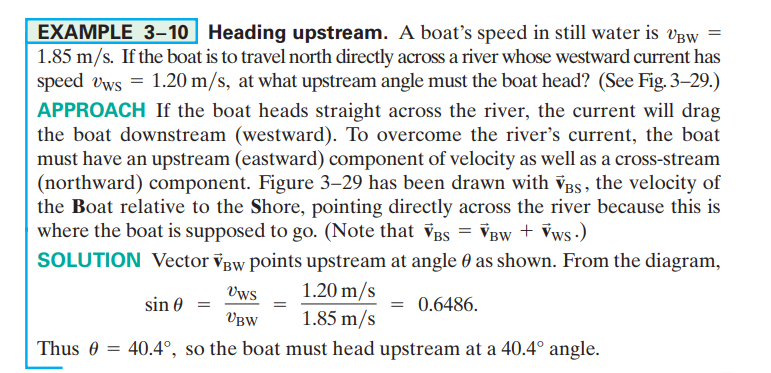EXAMPLE 3-10 Heading upstream. A boat's speed in still water is vgw = 1.85 m/s. If the boat is to travel north directly across a river whose westward current has speed vws = 1.20 m/s, at what upstream angle must the boat head? (See Fig. 3–29.) APPROACH If the boat heads straight across the river, the current will drag the boat downstream (westward). To overcome the river's current, the boat must have an upstream (eastward) component of velocity as well as a cross-stream (northward) component. Figure 3–29 has been drawn with vgs, the velocity of the Boat relative to the Shore, pointing directly across the river because this is where the boat is supposed to go. (Note that ves = ¥gw + Vws.) SOLUTION Vector vgw points upstream at angle 0 as shown. From the diagram, Vws 1.20 m/s sin 0 = 0.6486. VBW 1.85 m/s Thus 0 = 40.4°, so the boat must head upstream at a 40.4° angle.
Displacement, Velocity and Acceleration
In classical mechanics, kinematics deals with the motion of a particle. It deals only with the position, velocity, acceleration, and displacement of a particle. It has no concern about the source of motion.
Linear Displacement
The term "displacement" refers to when something shifts away from its original "location," and "linear" refers to a straight line. As a result, “Linear Displacement” can be described as the movement of an object in a straight line along a single axis, for example, from side to side or up and down. Non-contact sensors such as LVDTs and other linear location sensors can calculate linear displacement. Non-contact sensors such as LVDTs and other linear location sensors can calculate linear displacement. Linear displacement is usually measured in millimeters or inches and may be positive or negative.
(II) Determine the speed of the boat with respect to the
shore in Example 3–10.

Trending now
This is a popular solution!
Step by step
Solved in 3 steps with 2 images


